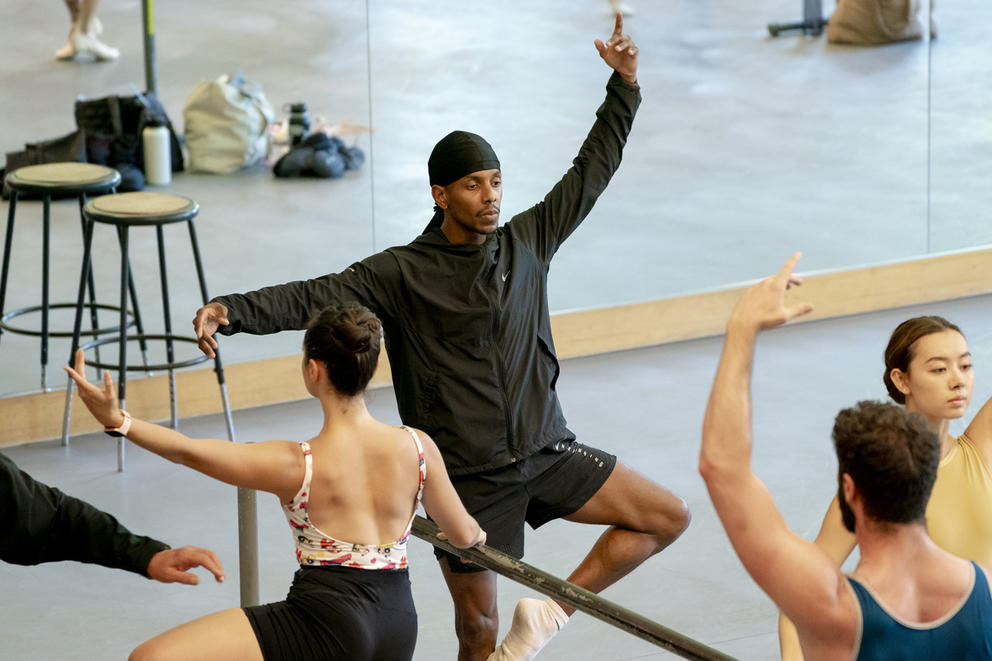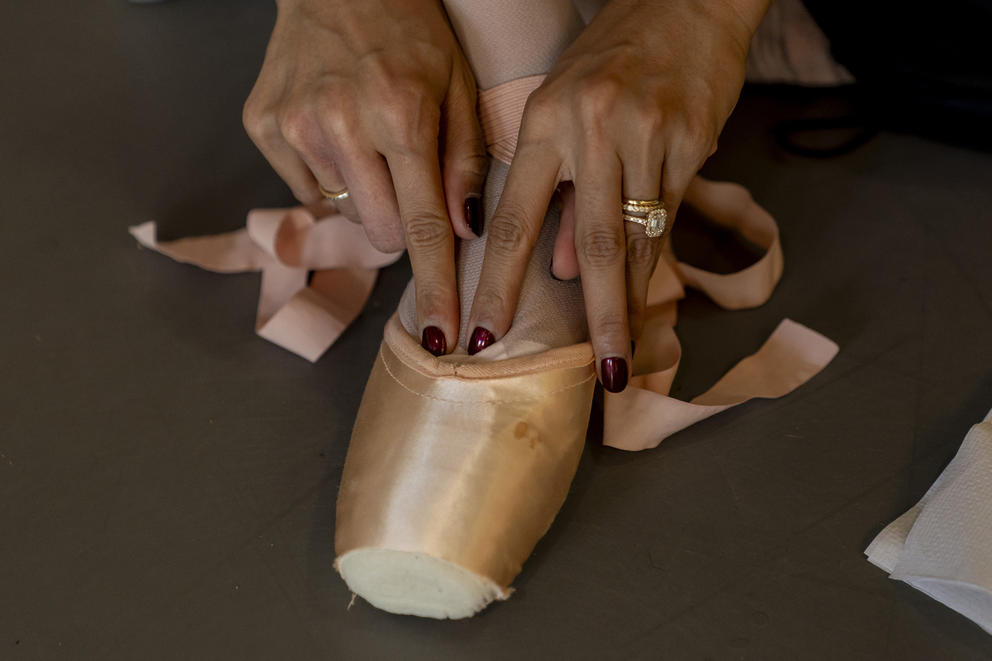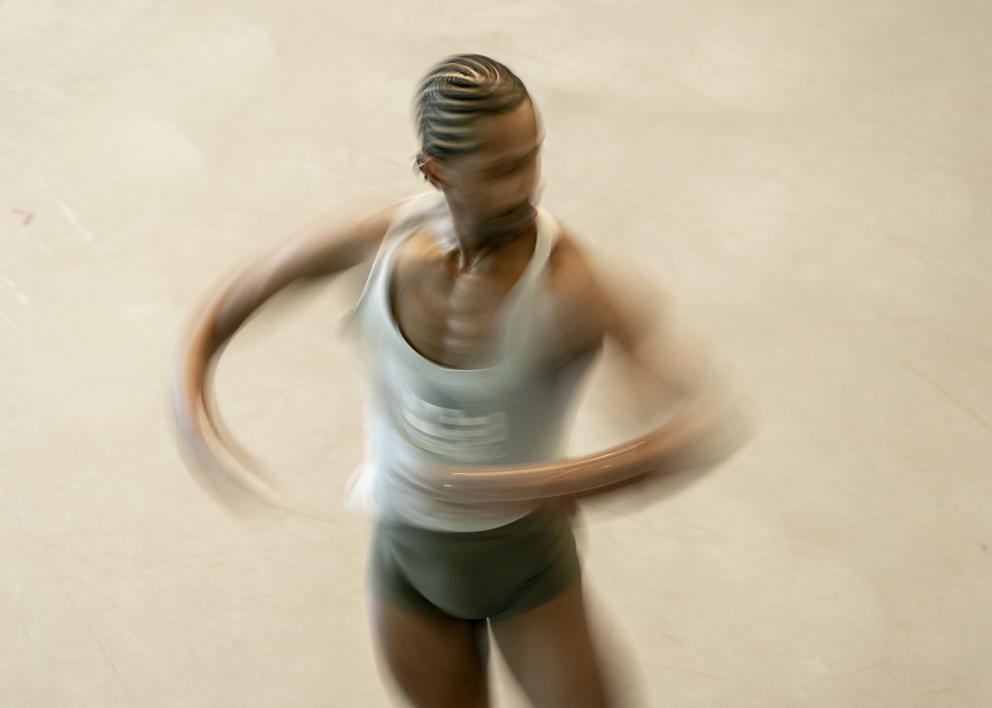Like many American ballet companies, PNB has been working hard in recent years to diversify its staff, both onstage and behind the scenes. Now, as it prepares to open its 51st season (starting Sept. 22), company dancers are more racially diverse than at any other point in PNB’s history. And they’re performing an ever-expanding repertoire of new works by an array of choreographers.
The mandate for change at PNB comes from the top, but energetic young dancers like Generosa are pushing that change — and their art form — into new territory.
Case in point: 20-year-old Destiny Wimpye. While still a student in the PNB School’s Professional Division, Wimpye, who is Black, performed as a flower and a snowflake in The Nutcracker. She also joined the Swan Lake flock and even got the opportunity to perform with the corps de ballet in George Balanchine’s neoclassical epic, Diamonds, a technically daunting challenge for experienced dancers let alone for a student.
Wimpye, who joins the company’s corps de ballet this season after serving a year as an apprentice dancer, is not your grandmother’s vision of a ballerina.
While versed in myriad dance styles (she originally trained in Los Angeles at the Debbie Allen Dance Academy), she gravitated toward ballet starting in her early teen years. Built more like a gymnast than the stereotypical willowy ballerina, Wimpye has a dazzling onstage presence, with a huge smile and powerful jumps. And she’s just one of many in PNB’s new guard who defy ballet stereotypes.
“I think all of us who have joined, we’re just pushing PNB in a strong direction,” Wimpye says. “It’s one of the reasons I wanted to join this company. I felt welcome, not just like another statistic or number.”
Moving toward balanced programming
Since arriving in Seattle in 2005, PNB artistic director Peter Boal has programmed dozens of ballets by contemporary choreographic superstars like Twyla Tharp, Crystal Pite, William Forsythe and Alexei Ratmansky. But Boal is also commissioning work from artists who haven’t yet reached the stratosphere of the dance world, and reaching out to choreographers who haven’t been well-represented on ballet stages.
Nationwide, women — outside of legends like Twyla Tharp — still represent a minority of the ballet choreographers whose works get full stage productions.
Of the 14 total dances presented in PNB’s 2022-23 lineup, female choreographers created four works. In the current artistic season, the company will again present works by four female choreographers — equaling about one-third of the full repertoire. (PNB’s annual production of The Nutcracker is not included in these counts, as it does not reflect programmatic trends.)
That’s not parity with male choreographers, but PNB is programming more work by women than most of its peer ballet companies, according to a new survey by the Dance Data Project, a gender equity index.
The DDP study found that the nation’s 10 largest ballet companies — a cohort that includes PNB — presented an average of just under 15% of works by women last year.
Another data point ballet statisticians are tracking: world premieres, which as with other contemporary ballets tend to draw younger audiences. (As of 2019, 30% of PNB ballet-goers were between 24 and 40, up more than five percent from five years earlier, when the company won a Wallace Foundation grant to help grow their audience.)
Last season, PNB presented a whopping seven world premieres; three created by women, and two by men of color — a reflection of Boal’s desire to refresh the company’s repertoire. This season contains only one world premiere, a short work by choreographer Danielle Rowe, included on the “Love and Loss” mixed bill.
In addition to attracting younger crowds, works beyond the old ballet chestnuts entice people who haven’t traditionally seen dancers who look like themselves on the Marion Oliver McCaw Hall stage.
Although PNB doesn’t currently have data on the racial identity of their ticket buyers, company administrators say anecdotally that they see a change in audience demographics. So do regular ballet-goers.
TraeAnna Holiday of Converge Media, an outlet that covers Seattle’s Black community, wrote in an email that while it has yet to be a major topic of community-wide discussion, she’s seen more diverse audiences at PNB performances.
“People are noticing this shift in diverse representation,” Holiday wrote. “PNB is setting a precedent in the industry; it’s impressive and notable.”
Even when PNB performs full-length classical ballets like Swan Lake and Nutcracker, the rows of tutu-clad swans or snowflakes on stage are no longer made up of identical white dancers with long necks, narrow hips and flat chests.
Now dancers wear shoes and tights that match their skin tones, and sometimes Black dancers free their hair from the tight buns that have been de rigueur for ballerinas.
As 25-year-old company member Kuu Sakuragi puts it, “Here, it’s OK to be yourself.”
That’s because Boal isn’t looking to hire dancers with particular skin colors or body types. He says it’s more important to him to find company members with the training and talent to perform both the classics and PNB’s growing roster of brand-new works.
To an outsider, PNB seems to be evolving into a contemporary ballet troupe, but Boal politely declines that moniker. “We’re a company that moves, a company that can dance,” he says.
Dance diversity by the numbers
While Boal emphasizes that changes at PNB go beyond numbers, the numbers do reflect the company’s cultural shift. PNB’s current roster of 45 dancers (expanding to 47 in November) is now more than 50% Black, Indigenous and People of Color (BIPOC).
From its founding days the company has included dancers of color, but very few have been Black. (The first African American dancer at PNB was Kabby Mitchell, hired in 1979.)
Although PNB enacted its first racial equity plan in 2016, George Floyd’s murder in May 2020 pushed the company to accelerate change.
“At that time, we had one dancer that identified as Black in our company,” Boal says. “It was sort of ‘Whoa, are we asleep at the wheel?’”
PNB now has six Black dancers and another six who are multiracial, plus 12 dancers of Asian, Hawaiian/Pacific Islander or Latino/Hispanic backgrounds. 21 current dancers identify as white.
The 50% BIPOC statistic is impressive when compared with PNB’s peer companies.
At New York City Ballet, the nation’s largest ballet company, 26% of the dancers identify as BIPOC, while at Boston Ballet, 35% of company dancers identify as BIPOC or mixed-race. At San Francisco Ballet, according to the company’s diversity initiative report, more than 30% of the organization’s employees are people of color, although the report doesn’t break out data for dancers specifically.
Ushering in a generational shift
And while ballet dancers are typically young — it’s a physically demanding art form, after all — currently PNB has very few dancers over 35. Since 2020, at the beginning of the pandemic, 10 principal dancers and soloists either retired or left PNB, including fan favorites Lindsi Dec, Benjamin Griffiths and husband/wife duo Laura and Jerome Tisserand, all in their late 30s.
Three dancers of color were among this recently departed cohort: Dec, William Yin-Lee and company star Noelani Pantastico, who was in her early 40s when she retired last year. Last June, PNB’s most senior dancer, Lesley Rausch, also retired. These departures have opened PNB’s roster to an influx of younger, more diverse artists.
At almost 30, Generosa is now a company veteran; Boal hired her in 2011. The New Jersey native trained at the prestigious School of American Ballet, the feeder for New York City Ballet. Although she was a standout student, NYCB didn’t hire her.
“I think, back in the day, they’d made their quota for one Asian person,” she says.
She was devastated, and contemplated quitting dance. Generosa had never considered joining a ballet company outside of New York until Boal offered her a job in Seattle.
“I got here and it was like, ‘Wow!’” she laughs. “It was the first time in my ballet journey where I thought, ‘This feels right.’”
Not every dancer of color has felt so immediately welcome at PNB.
Before the pandemic, 27-year-old Amanda Morgan, another PNB standout, had contemplated quitting her job. Often the only Black dancer in the studio, Morgan was frustrated by what she saw as the art form’s ingrained emphasis on white cultural values.
During the 2020 social justice protests, she began to speak out publicly, calling for Black representation and empowerment in the arts and specifically at her workplace.
Three years later, Morgan, who identifies as Black and Latina, has become a mentor to young Black dancers like new corps de ballet members Wimpye and 20-year-old Larry Lancaster.
“A lot of young dancers growing up, we don’t see a lot of representation,” Lancaster says. “I was blessed to come from Baltimore and see a lot of Black men that looked like me dancing classically. But on the professional level, it was a lot harder to find that same representation.” While Lancaster now cites a slew of PNB male dancers as role models, the princely Batista tops his list.
Morgan sees the cultural shift at PNB as generational as well as racial.
“When the pandemic happened, I had only been in the company three years, I was very young,” Morgan wrote in an email. “When we returned, I was a seasoned company member.”
She was 24 at the time. That’s young in the non-ballet world, but most ballet dancers get their first professional jobs in their late teens. That was true for Morgan as well as for many of the dancers PNB hired during and immediately after the pandemic.
Since her promotion, she’s tackling more challenging roles in the studio and onstage, but Morgan also feels freer to voice her concerns to Boal. That’s something she believes comes more easily to PNB’s other young dancers, who expect to have a say in the direction their careers will take. This new freedom, combined with the increasing number of BIPOC dancers, make PNB feel more welcoming to Morgan now.
For Boal, making room for staff input is key to helping to transform ballet’s traditional top-down culture. That in turn can help transform PNB into a truly inclusive organization.
“I used to think about running a ballet company,” says Boal. “Now I think of running a microcosm of the world. You walk through the doors and you feel like ‘Yes!’”
A dance advisor on point
Part of the cultural shift at PNB can be credited to New York-based consultant Theresa Ruth Howard, a former professional ballet dancer and founder and curator of the project Memoirs of Blacks in Ballet.
In 2015, Howard was invited to speak about diversity and equity in ballet at a national conference in Miami. “One of my stipulations was that I’m not talking to the choir,” Howard recalls. Organizers made sure to invite a group of ballet administrators; PNB executive director Ellen Walker was among them.
“I will never forget the way she [Howard] spoke,” Walker says. “Her insight into ballet, her personal experiences, things that worked and didn’t work for her. Afterwards I waited and waited in line and said, ‘Would you be willing to have a conversation with me?’”
PNB was the first ballet company to approach Howard to help them make changes.
“I was fresh off the boat,” Howard laughs. But she was impressed by Walker’s sincere desire to make PNB a more inclusive, welcoming organization, for both employees and audiences. For Howard, working with PNB was an opportunity to put her beliefs into practice — in particular her commitment to creating organizations that put people and their lived experiences at the center of their operations.
“I always say that organizations aren’t constructs, they’re people. And I don’t work on people, I work with people,” she says. “The very interesting thing about Pacific Northwest Ballet is that you have two leaders [Walker and Boal] who are vociferously committed to change.”
While Boal does the artistic hiring and decides which ballets to program, it’s Walker who signs off on the budget: everything from a choreographer’s fee to the funds to build costumes and buy tights and pointe shoes to match each dancer’s skin tone.
“If you’re going to center the human beings who are performing, then it’s important to evaluate all the tools they use to do their jobs,” Walker says. “The tights, the shoes and the costumes, in a way that acknowledges and celebrates their individuality.”
That includes rebuilding costumes for dancers who spent their summer vacation in the sun. An internal sign posted the week dancers returned to work last month advised those whose tans might have altered their usual skin tones to report to the costume shop for an updated color match.
Watch for what’s working
Even in this post-pandemic era, when audiences for live performances are slow to return to theaters, PNB’s evolution has attracted attention from people who hadn’t been ballet fans. Audiences filled McCaw Hall for performances of Pite’s The Seasons’ Canon, for example, a nontraditional contemporary work for more than 50 dancers, performed in front of a digital light installation.
“Exciting, exhilarating, magnificent,” one audience member wrote PNB afterwards. “I experienced Crystal Pite’s Seasons’ Canon and was blown away,” wrote another. “Thanks to PNB management for supporting innovative dance.” The company is reprising Pite’s piece “by popular demand” in April, 2024.
Sitting in the theater, watching new works that haven’t traditionally been part of a ballet company’s repertoire performed by a diverse group of artists — including non-binary dancers in pointe shoes — even a skeptical journalist taught to question everything might wonder if PNB truly is on the path to creating some kind of ballet utopia.
Howard counsels observers to trust their gut reaction; PNB’s transformation feels authentic because it is authentic.
“We’re always looking for what’s not working, so our eyes haven’t adjusted to look for evidence that it is,” she says. “This work is very quiet. It’s really invisible until it’s visible.”
PNB’s journey toward equity, diversity and inclusion is ongoing; Howard still meets regularly with Walker, and when she’s in Seattle, holds what she calls office hours for PNB dancers. Walker, Boal and associate artistic director Kiyon Ross (the second African American dancer promoted to soloist at PNB, 28 years after Kabby Mitchell retired) also meet regularly with dancers to monitor their progress and field any questions or concerns.
For Walker, this work is both deeply personal and consequential, something she looks at with great pride.
Dancers like Generosa share Walker’s sentiment. These days she barely gives a thought to the New York ballet career she once desired. Seattle is her home, and she calls PNB part of her family.
“It’s magic,” Generosa says. “Just magic.”
Get the latest in local arts and culture
This weekly newsletter brings arts news and cultural events straight to your inbox.










